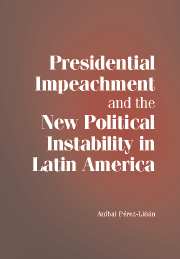Book contents
- Frontmatter
- Contents
- List of Tables and Figures
- Preface and Acknowledgments
- 1 INSTITUTIONAL CRISES IN PRESIDENTIAL REGIMES
- 2 FIVE CASES OF IMPEACHMENT AND A PRESUMED MADMAN
- 3 PRESIDENTIAL CRISES AND THE DECLINE OF MILITARY INTERVENTION
- 4 LATIN AMERICA IN THE AGE OF SCANDAL
- 5 SCANDALS AND THE POLITICAL ECONOMY OF POPULAR OUTRAGE
- 6 BUILDING A LEGISLATIVE SHIELD: THE INSTITUTIONAL DETERMINANTS OF IMPEACHMENT
- 7 TOWARD A NEW PATTERN OF POLITICAL INSTABILITY
- 8 RETHINKING LATIN AMERICAN PRESIDENTIALISM
- References
- Index
- Titles in the series
7 - TOWARD A NEW PATTERN OF POLITICAL INSTABILITY
Published online by Cambridge University Press: 25 July 2009
- Frontmatter
- Contents
- List of Tables and Figures
- Preface and Acknowledgments
- 1 INSTITUTIONAL CRISES IN PRESIDENTIAL REGIMES
- 2 FIVE CASES OF IMPEACHMENT AND A PRESUMED MADMAN
- 3 PRESIDENTIAL CRISES AND THE DECLINE OF MILITARY INTERVENTION
- 4 LATIN AMERICA IN THE AGE OF SCANDAL
- 5 SCANDALS AND THE POLITICAL ECONOMY OF POPULAR OUTRAGE
- 6 BUILDING A LEGISLATIVE SHIELD: THE INSTITUTIONAL DETERMINANTS OF IMPEACHMENT
- 7 TOWARD A NEW PATTERN OF POLITICAL INSTABILITY
- 8 RETHINKING LATIN AMERICAN PRESIDENTIALISM
- References
- Index
- Titles in the series
Summary
The episodes of impeachment described in previous chapters constitute part of a broader trend, a new pattern of political instability that emerged in Latin America in the 1990s. Between the fall of the Collor administration and the end of 2004, ten Latin American presidents were removed from office. In about half of the episodes, the outcome of the crisis was an impeachment or a declaration of incapacity. In the remaining cases, presidents were ousted by other means. In no case, however, was the demise of the president followed by the establishment of an authoritarian regime.
Why were some presidents ousted without an impeachment process? What do these cases tell us about the hypotheses developed in previous chapters? In the first section of this chapter, I discuss two paradigmatic episodes of presidential removal without impeachment proceedings: the fall of Presidents Fernando de la Rúa and Adolfo Rodríguez Saá of Argentina in 2001. The Argentine crisis illustrates some of the general characteristics of the new pattern of instability. Similar cases of removal without impeachment took place in other countries, and they are summarized in the second section.
In the third section of the chapter, I identify the distinctive traits of the emerging pattern of instability and return to the hypotheses outlined in Chapter 2. The impact of declining military intervention, rising scandals, popular uprisings, and weak legislative support is tested in the next two sections, where I conduct a qualitative comparative analysis of twenty-four presidential crises and then perform a broader statistical test for seventy-five administrations.
- Type
- Chapter
- Information
- Publisher: Cambridge University PressPrint publication year: 2007



